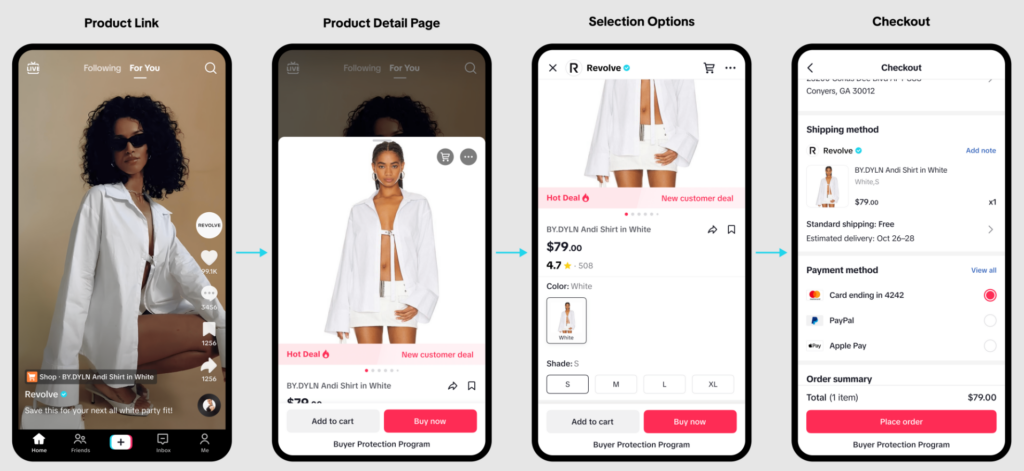TikTok has made some strong gains in the recent social media market share including growth in advertising revenue earned from TikTok ads.
According to Investopedia, as of 2023, TikTok dominates the youth market. In the United States, TikTok has surpassed YouTube in average time spent on the platform within the last year.
The Harvard Business Review reports that TikTok’s one billion users spend an average of 95 minutes on the platform, in comparison with YouTube’s 74 minutes (though it does have twice the number of users).

This is due to several reasons:
Short form, engaging content: The platform’s infinite scroll feature enables users to continuously watch videos without having to click or search for new content.
The short videos also provide immediate entertainment, so users are inclined to watch ‘just one more’ video repeatedly.
Personalized recommendation: TikTok’s machine learning algorithm analyzes user behavior to curate a feed of tailored content that matches a user’s interests.
The platform’s ‘For You Page’ is continually updated with fresh and relevant content that creates an endless stream of videos that uniquely cater to individual preferences.
Creative tools: The easy-to-use editing tools (video trimming, merging, special effects), filters and effects, music, and sounds make content creation an accessible as well as enjoyable art for users to partake in.

Trends: Whether it’s a dance challenge, a hashtag challenge, a cooking trend, or a lip-syncing meme, these trends invite users to watch, create, and share their own content.
What’s more, users can put their own spin on trends encouraging the creation of new trends and the potential to go viral on the platform. This desire for recognition motivates users to spend more time on the platform, creating and sharing content.
Commerce: See something you like on TikTok? It could be yours too. The platform’s commerce features integrated directly into the platform enable users to discover and shop for products they like without leaving the platform.
Its seamless integration of shopping features into its never-ending stream of entertainment content makes shopping feel less like a chore and more like a natural extension of the platform’s browsing experience.

TikTok also hosts live shopping events in which users can interact with hosts and make purchases in real-time. The fleeting nature of such content creates a sense of urgency and excitement amongst users. Due to FOMO (fear of missing out), users are inclined to stay engaged on the platform for the duration of the event.
It is reportedly an excellent platform for small businesses to thrive with statistics revealing that up to 30% of Gen-Z users access TikTok to discover new products and 49% of all users use the platform to help them make purchasing decisions.
Community engagement: Due to the prioritization of user-generated content (UGC) from everyday people, TikTok has been able to create an inclusive environment where everyone can participate and create content they’re passionate about.
Interactive features such as polls, and Q&A sessions facilitate personalized interaction, thus forming communities around specific interests or personalities.
TikTok Ban No More?
A Forbes article titled ‘A TikTok Ban Would Be A Godsend For YouTube And Instagram’ reported in early 2023 that TikTok has surpassed both platforms in user engagement, posing a competitive threat to these established platforms.
From Trump to now Biden, both administrations have pushed for TikTok’s exit in the United States. Despite several creators having spoken out against the ban as it would greatly affect their careers and livelihood, the U.S government is dead set on banning the application.
This was and is still largely due to diplomatic tensions with the nation’s greatest economic rival, China and its national ownership of the application.
There is the concern that the user data is collected and shared with the Chinese government leading to the potential misuse of sensitive information of American users.
TikTok was banned in India early on in June 2020 due to similar reasons, and now the uncertainty of its livelihood in the U.S. has prompted creators to start utilizing other platforms that prioritize the creation of similar, short-form content such as Instagram’s Reels and YouTube’s Shorts.
To a certain extent, it almost seems like an act of desperation as creators will be left with no choice but to utilize alternative, less-apt platforms and to adapt to new regulations which disrupts their established audiences and creative workflows.
To quote, Kat Buno, a 22-year-old beauty and gaming vlogger stated that ‘If TikTok does get banned, my whole focus will be on YouTube. That’s literally my only plan.
This would clearly pose a gap in the market for YouTube and Instagram to capitalize on their short-form or ephemeral content. But as reported by Forbes, the mass migration of creators to these platforms may over-saturate them leading to the dissipation in recognition of UGC.
As stated above, TikTok is a favorite amongst creators due to its easy-to-use tools and constant release of new features and filters. Both Instagram and YouTube’s creative tools are fairly limited in this sense.
Hence, a shift from TikTok will drastically lead to a shift in the kind of content users consume and create, as creators will seek to replicate or reinvent their content strategies on other platforms that have different formats, audience demographics, and community dynamics.
For better or for worse, this transition will reshape digital content trends and influencer culture, further influencing how online audiences engage and perceive social media content at large.
Nonetheless, it doesn’t look like TikTok’s going anywhere anytime soon in the U.S. Despite regulatory scrutiny and concerns over data privacy having persisted, the situation remains fairly dynamic.
Even Donald Trump, who once tried to ban the application, is now a TikTok star.
End Of YouTube?
In 2022, the Guardian reported that YouTube’s revenue took its first dip since the rise of TikTok. As stated, YouTube’s revenue dip underscores the competitive pressure it faces in retaining advertisers and maintaining revenue growth amidst TikTok’s rise. Managing TikTok ads is becoming easier with new features being released in monthly sprints while YouTube Ads Management is becoming more packaged with campaigns like the Performance max.
What’s more is that unlike YouTube, TikTok’s influence extends beyond user engagement to shaping broader content trends. This affects how platforms like YouTube choose to strategize and innovate entirely.
YouTube may have been a pioneer in the creation of UGC but its dominance in the digital space is faltering. Despite enhancing creator tools, and exploring new revenue streams to maintain its relevance, there are a few key reasons for its gradual decline. These include:
Content moderation issues: YouTube has faced criticism for its selective handling of controversial or harmful content on its platform. Wired reported way back in 2018, that even YouTube ‘doesn’t know where its own line is’.
Free speech enthusiast, Elon Musk might say moderation is another word for censorship and according to critics and creators, he’s not wrong. It is alleged that content that fails to align with YouTube’s belief system or political affiliations is automatically shadow banned or demonetized.

It goes without saying that hate speech, misinformation, and harmful challenges should be removed but its inconsistent enforcement alongside reliance on public and stakeholder pressure has led to disparities in its policies.
Monetization concerns: With its moderation issues, YouTube’s policies regarding eligibility for monetization such as watch time, subscriber count, and most importantly adherence to community guidelines is impacted.
For businesses and marketers, the fluctuation in ad revenue due to constant changes in ad formats, and engagement levels underscores the platform’s ability to navigate digital advertising strategies.
In contrast, TikTok’s monetization process is often perceived as much simpler compared to YouTube’s Partner Program (YPP). Users can earn revenue from their content without needing to meet specific subscriber counts or watch time.
Ads, ads, and more ads: YouTube has started featuring longer, unskippable ads that interrupt a user’s viewing experience. Ads are frequently known to appear in the middle of videos disrupting the overall viewing experience.
User’s are more likely to click out of a video rather than wait for an ad to play through, leading to lower revenue for advertisers and creators.
On the other hand, TikTok’s approach to advertising still focuses on shorter, skippable formats that integrate more seamlessly into the user experience.
Despite the criticisms it faces, YouTube is entrenched as a cornerstone of the digital landscape. It is unlikely the platform will diminish in relevance anytime soon. While it faces competition from TikTok, most digital platforms are never stagnant in nature and constantly evolve over time.
Now might be TikTok’s moment to shine, but the TikTok vs. YouTube saga is far from over. Like other digital platforms, YouTube will further innovate to incorporate features that rival TikTok’s followed by the latter doing the same. And let’s just say, as long as social media persists, this cycle is never ending.
A New Search Engine Tool
YouTube is not the only platform that has to worry about the advent of TikTok. According to the New York Times, TikTok has become a primary search engine for Gen Z users, surpassing Google’s dominance in certain contexts. For instance:
Content discoverability: Gen-Z have been increasingly turning to TikTok not only for entertainment but also for access to information and education. This is because TikTok’s algorithm recommends content based on user preferences and trends, thus providing quick and relatable answers to queries.
For instance, 15-year-old high school student Ja’Kobi Moore scrolled TikTok to learn how to source a ‘teacher letter of recommendation’ while applying to private school in her hometown. Would this have a bigger impact on digital marketing or how brands approach search is a question for the future.
The two videos she viewed were both made by teachers, one explaining how to ask for a letter of recommendation and the other providing a template. Both videos provided answers much faster than a google search and were easier to understand.
Bite-sized information: TikTok’s format, which prioritizes short, straight-to-the-point content appeals to users, especially Gen-Z users who prefer visual and concise information over traditional, long-form text-based search results from Google.
However, TikTok has started experimenting with long-form content. At present, user’s can view and upload content up to 10-minutes long but in the future, there is the potential that the platform could facilitate 30-minute long videos.
This could potentially impact the platform’s relevance as it presents a dilution of its core strengths (the success of the platform was initially built on its short form, quick-to-consume video format), and competitive landscape.
As emphasized, TikTok’s competitors, YouTube and Instagram already specialize in long-form content. With its primarily younger user base, TikTok risks decreased engagement with its core demographic that prefers quick, engaging content. Longer videos may pose challenges in terms of algorithmic recommendations and user retention.
Algorithmic advantage: As mentioned prior, the platform’s algorithmic recommendation system is seen as more intuitive and responsive to a users’ interests compared to Google’s search algorithm which predominantly relies on keywords and links.
On TikTok, you can search for hashtags and keywords related to topics of interest and relevant videos related to your query will pop up. The focus content discovery streamlines the search process as users find it easier to find content that matches their interests without the need for complex search terms or filters.
Ultimately, as reported by the Verge, TikTok’s algorithms and content aren’t yet designed or fine tuned to replace Google as a search engine.
However, YouTube probably should be concerned by TikTok’s growing prowess.
